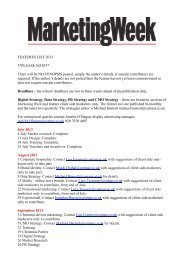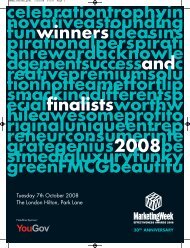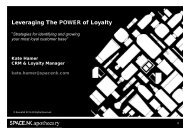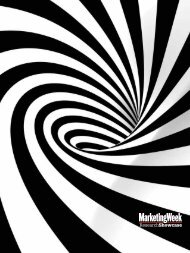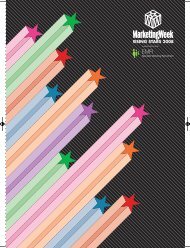Interactive Seven 2009 Supplement - Marketing Week
Interactive Seven 2009 Supplement - Marketing Week
Interactive Seven 2009 Supplement - Marketing Week
Create successful ePaper yourself
Turn your PDF publications into a flip-book with our unique Google optimized e-Paper software.
MWIB_260209_p039 19/2/09 17:48 Page 39<br />
INTERACTIVE USER-CENTRED DESIGN<br />
Who wants<br />
your<br />
website?<br />
When it comes to designing a<br />
new website, some companies<br />
will still try to put aesthetic<br />
tastes or commercial drivers<br />
at the forefront of their<br />
online proposition. While<br />
this may give you a site that<br />
looks great graphically and<br />
makes the stakeholders<br />
happy, the real question you<br />
should be asking yourself is:<br />
“Will this make our users<br />
happy?” If the answer is no,<br />
then making your website a<br />
commercial success could be<br />
an uphill struggle.<br />
The old adage that “the customer is always right” still applies<br />
in the online world, and it is crucial that your website is designed<br />
based on what your users want, rather than purely what you<br />
want. Many organisations have realised this and have employed<br />
user-centered design (UCD) to create new or updated websites.<br />
UCD is the process of designing websites primarily around<br />
the needs of your target users, rather than commercial goals. The<br />
design process involves the user at every stage, with the first step<br />
involving research to establish user needs. Initial site designs are<br />
then created accordingly and tested by users, with adjustments<br />
made based on the feedback.<br />
Think about when you’re launching a new product. You will<br />
generally either carry out, commission or consult some market<br />
research to give you a better chance of success. The process<br />
should be very similar when launching a new website. Researching<br />
your target user base can give you a very specific viewpoint<br />
which will allow you to ensure that your proposition is grounded<br />
in genuine user needs. This will give you confidence that there is<br />
demand for your proposition before taking it to market.<br />
In today’s highly competitive online environment, there is an<br />
overwhelming pressure on marketers to ensure their content and<br />
websites are easy to use. With the proliferation of broadband connections<br />
and the continuing online shopping boom (in spite of<br />
the economic climate), online consumers have a lot of choice. If a<br />
user finds a website difficult to use, they will just give up and<br />
choose a rival’s site instead.<br />
If you fail to put user needs at the centre of your website<br />
design, then you may find that all the online marketing in the<br />
world could be in vain, as your sales gradually decline in the<br />
face of a competitor that has built its site around the needs of<br />
its users.<br />
Trenton Moss, Director, Webcredible<br />
T: 0870 242 6095, E: info@webcredible.co.uk<br />
W: www.webcredible.co.uk<br />
Simplicity<br />
sells<br />
As competition grows in the everexpanding<br />
online shopping market,<br />
brands must ensure their site is quick<br />
and easy to navigate for users.<br />
By David Benady<br />
Websites for packaged grocery brands, financial services products<br />
and top fashion marques are among the most cluttered,<br />
off-putting and hard to use on the internet. This is the verdict<br />
of usability consultants who believe many brands are<br />
failing to create easy-to-use websites and could be losing sales and brand<br />
loyalty as a result.<br />
The consultants have identified brands, including Norwich Union,<br />
Dior and Ralph Lauren, as missing a trick when it comes to website<br />
usability. They either trip users up when asking for contact details or<br />
employ hi-tec introduction pages, videos and interactivity that take an<br />
age to load.<br />
By contrast, sites for brands such as WH Smith, Hamleys, Apple and<br />
the BBC are scoring highly in the usability stakes. They make<br />
it easy for users to find the information they need and are structured in<br />
a logical and easy-to-navigate fashion.<br />
Web 2.0 has opened up the internet to a new array of tools which<br />
enhance social interaction, but have added an extra layer of complexity<br />
that may detract from the flow of communication. The urge to turn<br />
sites into over-crowded emporia of video, games and other interactive<br />
add-ons has made the user experience<br />
on many sites busy, confusing<br />
and unclear.<br />
The best sites put the needs of<br />
the end user at the heart of their<br />
designs. Easy-to-use websites offer<br />
brands huge benefits, such as keeping<br />
enquiries to call centres to a<br />
minimum, building loyalty among<br />
customers and ensuring shopping<br />
carts are not abandoned before the<br />
check-out.<br />
But given that the internet era<br />
is more than ten years old, it is surprising<br />
how many sites fail to see<br />
the world from the customer’s point<br />
of view. “Too many brands are still<br />
forcing their messages on the consumer<br />
and designing sites that represent<br />
the company’s view and<br />
Pretty but difficult: Ralph<br />
Lauren’s site is an example of how what they think the user might<br />
bad usability can trip users up want,” says Mo Rogers, direc- <br />
<strong>Marketing</strong> <strong>Week</strong> <strong>Interactive</strong> 39




